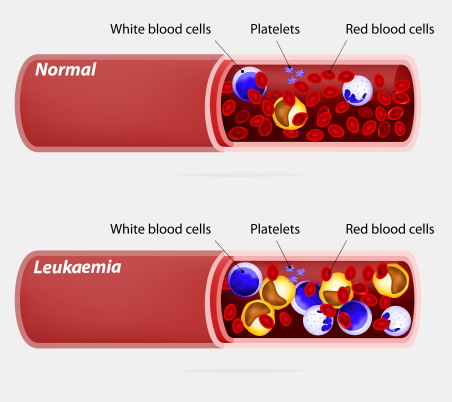Leukaemia
Types of leukaemia
Leukaemia is usually named by how quickly the cancer starts and grows, and which type of blood cells are affected.
- Acute — fast developing and growing.
- Chronic — slowly develops over months or years.
- Lymphoid — starts in cells that would normally become white blood cells.
- Myeloid — starts in cells that would normally become red blood cells and platelets (cells that cause clots and help stop bleeding).
There are 4 main types of leukaemia.
- Acute lymphoid leukaemia — more common in tamariki (children).
- Acute myeloid leukaemia — more common in older people.
- Chronic lymphoid leukaemia — accounts for most cases of leukaemia, and affects older people.
- Chronic myeloid leukaemia — most common in older people.
Causes of leukaemia
The cause of leukaemia is not known. There are some factors that may increase your risk of developing it, including:
- certain genetic conditions carry a risk of developing leukaemia including Downs Syndrome
- radiation exposure, including radiotherapy
- chemical exposure, such as benzene and some drugs used in organ transplants and cancer treatments
- some health conditions like blood disorders or those that lower your immune system.

In a healthy bloodstream there are the right amount of different blood cells. In a bloodstream with leukaemia, there can be too many or too few different blood cells.
Symptoms of leukaemia
Due to the low levels of normal blood, symptoms of leukaemia can include:
- tiredness
- pale skin colour
- repeated infections
- red skin blotches, bruising and abnormal bleeding
- loss of weight for no reason
- aching bones and joints.
These are also symptoms of many other diseases. In some types of leukaemia, there is no sign that you have it until it reaches an advanced stage.
Diagnosing leukaemia
Leukaemia is diagnosed from a blood test or a bone marrow sample (biopsy).
Treating leukaemia
The treatment depends on the person and the type of leukaemia. The main aim of the treatment is to get rid of the abnormal cells, allowing the normal cells to grow in the bone marrow again.
Acute leukaemia needs to be treated right away and is usually intensive. Treatment may include:
- chemotherapy
- stem cell or bone marrow transplants.
Chronic leukaemia may not need to be treated for some time, but will need treatment eventually. Treatment may include:
- chemotherapy
- targeted therapies to block the number of abnormal cells being created
- stem cell or bone marrow transplants.
Cancer support
Once someone has been diagnosed with cancer, we know there are some difficult days ahead. No matter where you are on the cancer pathway, there is always someone to connect with for support.
There are local services available to help make things easier for you and your whānau.
Cancer support (search) — Healthpoint (external link)
There are a number of benefits of belonging to a support group.
Education and support programmes — Leukaemia & Blood Cancer New Zealand (external link)